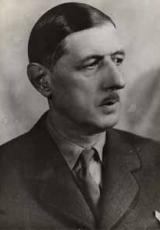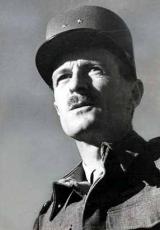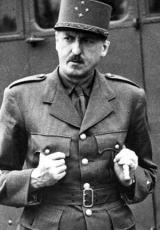The liberation of Paris
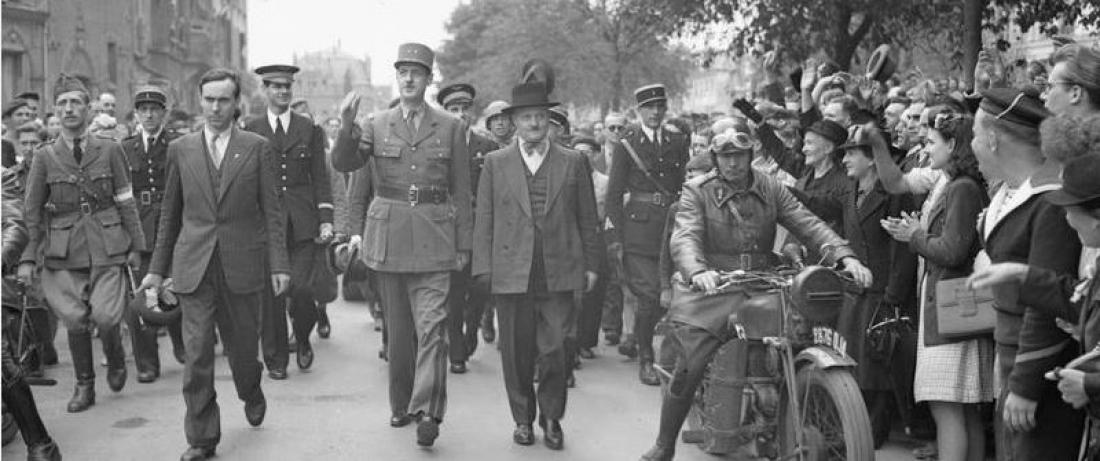
After reducing the Falaise Pocket in Normandy, on 19 August 1944 the Allied armies advanced swiftly to Rouen and Mantes, where a bridgehead was established on the Seine. In the meantime, on 18 August Paris had taken up arms. General de Gaulle had planned for General Leclerc's 2nd Armoured Division (2nd DB) to liberate the capital.
Paris is not a military objective
According to the Allied plans, Paris was not a military objective and the city should be bypassed. But General de Gaulle, the head of the Provisional Government of the French Republic, saw the liberation of the capital as symbolic and hence considered it a political objective: Paris must be liberated by French soldiers. De Gaulle wanted to be seen as the leader of a country that liberated itself by its own efforts. Moreover, with the bombing of strategic junctions in northern and western France, Paris was one of the few communication nodes to remain intact, and was therefore crucial to the German forces' withdrawal to the east, and also to the Americans as they continued to advance north and eastwards.
The Parisian barricades
On 10 August, the national military committee of the Francs-Tireurs et Partisans (FTP) issued an order for revolt. On 11 August, railway workers across the Paris area staged a strike, which rapidly spread, while the senior command of the French Forces of the Interior (FFI) in Paris, under Colonel Rol-Tanguy, moved into the underground rooms under Place Denfert-Rochereau. On 15 August, the CGT union called for a general strike. The police went into action, contributing a large contingent of armed men, who were a well-disciplined force in the midst of the revolt. Postal workers in turn went on strike, followed by press workers and metro employees. While Paris was taken over by liberation fever, one last night train left Pantin station, carrying some 2 400 deportees.
Across the city, Resistance fighters built barricades. The police turned the Paris police headquarters into a stronghold. There were violent clashes between the Germans and the Resistance, integrated in the FFI. On 20 August, a ceasefire was called, thanks to the Swedish consul, Raoul Nordling. But the very next day, on a decision of the Parisian liberation committee, the truce was broken and the street fighting resumed. The poorly armed Resistance fighters faced 20 000 German troops equipped with tanks and supported by aircraft, under the command of General von Choltitz, appointed head of Groß-Paris. For Hitler, ”Paris must not fall into the hands of the enemy except as a field of ruins.”
The 2nd DB
Fearing that the Germans would overcome the Parisian Resistance, General de Gaulle insisted that the Americans allow the 2nd DB to march on Paris. On 21 August, an envoy sent by Rol-Tanguy managed to cross the German lines and warn Leclerc: Allied intervention was needed, or else the Parisian revolt would end in a bloodbath. While General von Choltitz's men tried to regain control of the city, on 22 August General Eisenhower agreed that the 2nd DB, together with the US 4th Infantry Division, should make a rush for Paris. In late afternoon, a Piper light aircraft, piloted by Captain Callet of the 2nd DB, flew over the city and his observer, Lieutenant Mantoux, threw a message from Leclerc on weighted paper into the courtyard of the police headquarters: ”Stand firm, we're on our way.”
On the morning of 23 August, the 2nd DB, supported on its right flank by the US 4th Division, set out. The Germans had formed a solid line of defence from Trappes to Fresnes, south of Paris. Violent fighting took place in Palaiseau, Champlan, Toussus-le-Noble, Jouy-en-Josas, Clamart, Longjumeau, Wissous, Fresnes and Antony. On 24 August, the entire division was stalled by German ”hedgehogs” outside Paris.
At the junction of Croix-de-Berny, congested with the division's vehicles, Leclerc hastened the advance of his units and, at 7.30 pm, decided to send a detachment to Paris under the command of Captain Dronne, with three tanks, half-tracks and 150 men.
Thus, at nightfall on 24 August 1944, the first soldiers of the 2nd DB entered Paris, by the Porte d'Italie. They were the 9th Company of the Chad Infantry Regiment, or the ”Nueve”, comprising 146 Spanish Republicans or men of Hispanic origin, of a total of 160. Followed up by three Sherman tanks of the 501st Combat Tank Regiment, Dronne reached city hall at 8.45 pm. There he met Bidault, Luizet and Chaban-Delmas. French radio announced the 2nd DB's arrival. The great bell of Notre-Dame rang out.
Paris will not burn
At dawn on the 25th, the 2nd DB entered Paris by the Porte de Saint-Cloud, Porte d'Orléans, Porte de Gentilly and Porte d'Italie. Leclerc went through the Porte d'Orléans, met Chaban-Delmas at Place Denfert-Rochereau, then made his way down the Avenue du Maine to Gare Montparnasse station, where he set up his command post. Meanwhile, the 4th US Infantry Division entered Paris by the Porte d'Italie.
The people of Paris were surprised to see French soldiers, and gave them an enthusiastic welcome. The harried Germans took refuge in a small number of strongpoints. But the fighting was difficult and bloody at Place de la Concorde, Place de l'Étoile, Place de la République, at the Bastille and on Boulevard Saint-Germain. The largest strongpoint on the Left Bank of the Seine was the Palais du Luxembourg - the Senate - covered with small blockhouses and guarded by tanks. Fierce fighting pitted Germans against Resistance fighters in the Jardin du Luxembourg and the Palais.
Hôtel Meurice was attacked, and von Choltitz and his senior commanders were captured. At around 4 pm, in the staff apartment of police chief Luizet, the German general signed the act of surrender. Then he was taken to Gare Montparnasse, where he signed the order for ceasefire, which was circulated to the 20 German strongpoints still fighting. Colonel Rol-Tanguy co-signed the act of capitulation.
Shortly afterwards, Leclerc explained the situation to General de Gaulle, who had just arrived. While members of the National Council of the Resistance (CNR) and the Parisian Committee for Liberation (CPL) awaited him at city hall, de Gaulle headed for the war ministry, at Rue Saint-Dominique, to assume control and make known the re-establishment of State authority. It was not until 7 pm that he made his way to city hall, where he made what has since become a famous speech.
Paris liberated
Paris was liberated at a cost of a thousand FFI casualties, 582 civilians killed and 2 000 wounded, and 156 soldiers of the 2nd DB killed and 225 wounded. The enemy sustained 3 200 dead, while 12 800 were taken prisoner.
On 26 August, General de Gaulle visited the Arc de Triomphe, where he laid a wreath on the Tomb of the Unknown Soldier. Then he went down the Champs-Élysées with members of the government, CNR and senior French military leaders. Elated crowds of Parisians gathered all along the route taken by de Gaulle to Notre-Dame cathedral, cheering him and legitimating him as leader.
The presence of English-language press and radio reporters meant considerable coverage of the event around the world. Euphoric scenes took place in New York, Canada, in the streets of Montevideo and Buenos Aires. The liberation of the ”City of Light” symbolised the imminent defeat of Germany and Nazism.

25 août, combats à l'angle de l'avenue Victor Hugo et de la rue de Presbourg. Copyright Collection particulière

Au centre, le capitaine Dronne est le premier à être entré dans Paris, dans la nuit du 24 août 1944. A droite, le colonel de Langlade. Copyright Collection particulière

Le 26 août, devant l'arc de Triomphe, le général Leclerc. Copyright Collection particulière

L'accueil des Parisiennes aux marins du régiment blindé de fusiliers marins, le 26 août 1944. Copyright Collection particulière

Les chars légers du colonel de Langlade, sur les Champs-Elysées, le 26 août 1944. Copyright Collection particulière

Combat sur le petit pont, près de Notre-Dame de Paris, 25 août 1944. Copyright Collection particulière

Avenue de l'opéra, un jeep transporte un officier allemand venu pour donner l'ordre de reddition à des troupes qui continuent le combat. Copyright Collection particulière

Un char Sherman de la 2e DB entre à Paris, acclamé par des Parisiens. Copyright Collection particulière

L'accueil des Parisiens aux soldats de Leclerc. Copyright Collection particulière

Le général de Gaulle descend les Champs-Elysées, le 26 août 1944. Il est accompagné des membres du GPRF, du CNR et des chefs militaires. À sa droite, André Le Troquer, commissaire aux territoires libérés. Copyright Collection particulière

Une foule de Parisiens enthousiastes acclame des soldats britanniques. Paris, 26 août 1944. Copyright IWM - BU 21
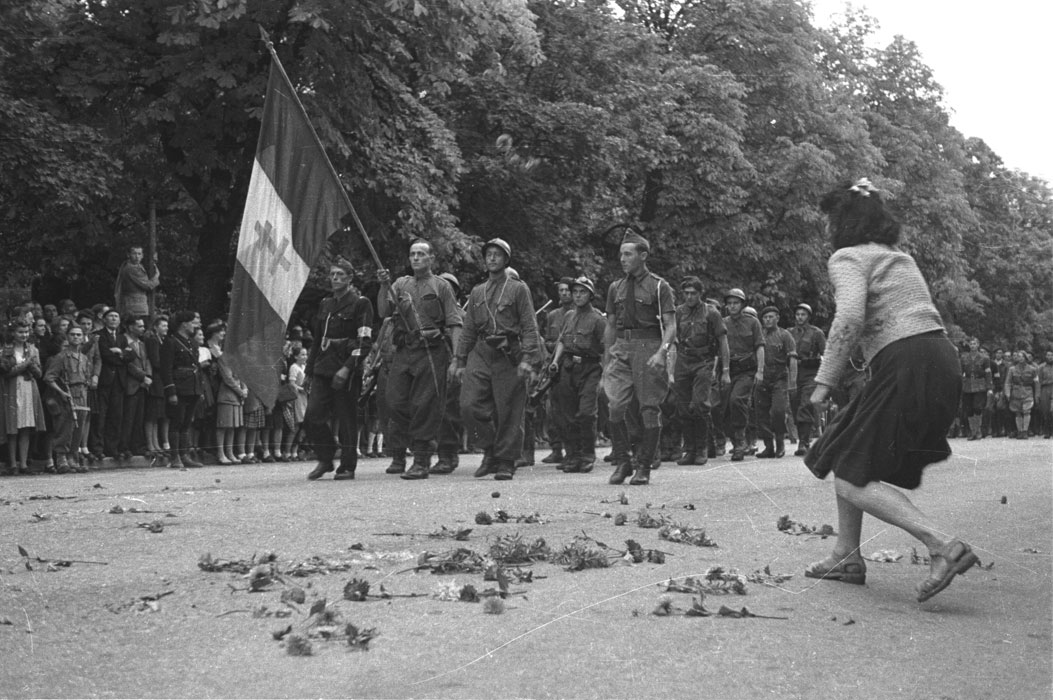
Un canon automoteur M-7 Priest (105mm) de la 2e DB sur le parvis de Notre-Dame-de-Paris, 26 août 1944. Copyright IWM - BU 129


